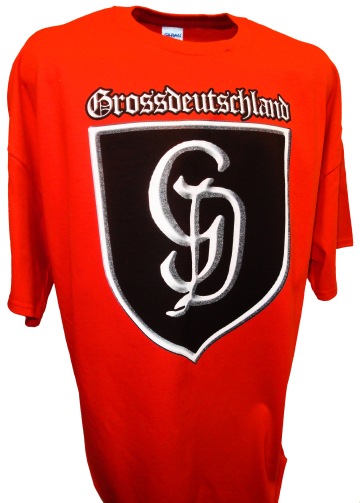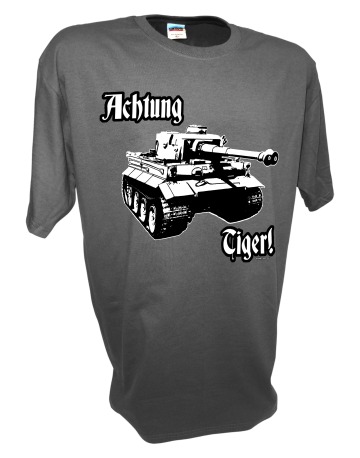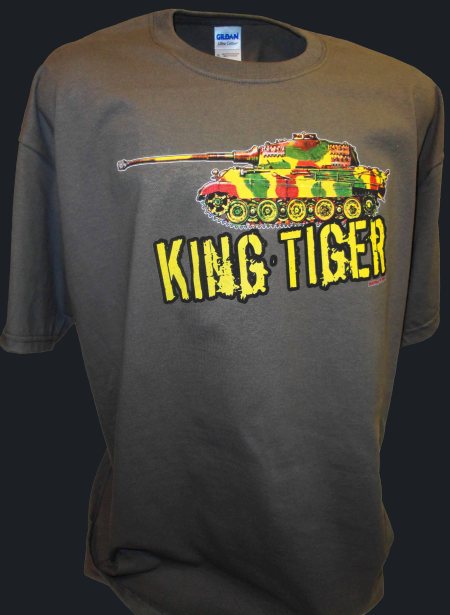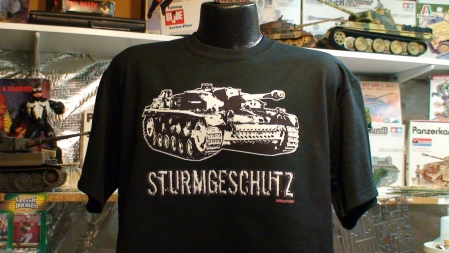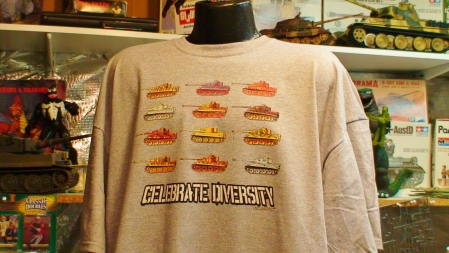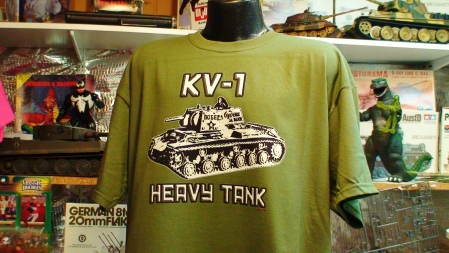Well we have a few new t shirt designs ranging all the way from German World War 2 Panzergrenadiers going “Back to the Front” to battle the “Slavic Hordes” to the patriotic “Victory” propaganda poster art that shows an American B17 or B29 bomber pilot. Also we have another Achtung Panther from a classic picture of a German Panther Panzerkampfwagen V crew in their Panther tank.
The US 76 mm gun, if firing the APCBC M62 ammunition, could penetrate the Tiger frontally out to just over 500 m, and could be at ranges in excess of 1,000 m to achieve penetration against the upper hull superstructure. Using HVAP ammunition, which was in constant sparse supply and primarily issued to tank destroyers, frontal penetrations were possible out to just over 1,500 m. It is worth mentioning that many of the penetration capabilities at longer ranges had little relevance compared to combat engagements of the real war, especially that which was fought in Western Europe, where battles seldom happened outside of one kilometer due to scattering and chance for human mistake, which is amplified greatly as range increases regardless of the ability of any cannon. For example, while a 17pdr could penetrate the front armor of a Tiger 1 at one kilometer in tests, during actual combat, a 17pdr gunner would probably never find himself in a position to actually attempt such a feat.
Tiger tanks were usually employed in separate heavy panzer battalions (schwere-Panzer-Abteilung) under army command. These battalions would be deployed to critical sectors, either for breakthrough operations or, more typically, counterattacks. A few favored divisions, such as the Grossdeutschland or some of the low-numbered Waffen-SS divisions had a small amount of Tiger tanks. The Tiger tank was originally designed to be offensive breakthrough weapon but by the time they came into action, the military situation had changed dramatically, and their main use was on the defensive as mobile gun batteries. Unfortunately this also meant scrambling the Tigers constantly from location to location causing excessive mechanical breakdowns. As a result there are nearly no instances where a Tiger Battalion went into combat at anything close to full strength. Furthermore, against the Red Army and Western Allied production numbers, even a 10:1 kill ratio would not have been sufficient for the Tiger tanks. Some Tiger tank units did exceed the 10:1 kill ratio, including 13. Kompanie/Panzer-Regiment Grossdeutschland (16.67to1), schwere SS-Panzer-Abteilung 103 (12.82to1) and schwere Panzer-Abteilung 502 (13.08:1). These numbers must be set against the opportunity cost of building the expensive Tiger tank. Every Tiger tank built cost as much as four Sturmgeschutz III assault guns.On 7 July 1943, a single Tiger tank commanded by SS-Oberscharfuhrer Franz Staudegger from the 2nd Platoon of 13th Panzer Company of 1st SS Division Leibstandarte SS Adolf Hitler engaged a group of about fifty Soviet T-34
tanks around Psyolknee (the southern sector of the German salient in the Battle of Kursk). Staudegger used all his ammunition in destroying 22 Soviet tanks, while the rest retreated. For this, Staudegger was awarded the Knight’s Cross.On 8 August 1944, a individual Tiger commanded by SS-Unterscharfuhrer Willi Fey from the 1st Company of sSSPzAbt 102, engaged a British tank column, destroying some 14 out of 15 Sherman tanks, followed by one more later in the day using his final two rounds of ammunition. sSSPzAbt 102 lost all of its Tiger tanks during fighting in Normandy, but reported 227 Allied tanks destroyed in six weeks.The Tiger tank is often associated with SS Haupsturmfurher Michael Wittmann of schwere SS-Panzerabteilung 101. He worked his way up, commanding assorted vehicles and then finally a Tiger I. In the Battle of Villers-Bocage, he destroyed over two dozen Allied vehicles including several tanks; and single-handedly defied the advance of the entire 7th Armored Division until his panzer was destroyed and abandoned.Over ten Tiger panzer commanders had over 100 vehicle kills on their account, including: Kurt Knispel with 168 destroyed, Otto Carius with 150+ kills, Johannes Boumllter with 139+ destroyed, and Michael Wittmann with 138 destroyed.
KONIGSTIGER TIGER II
Tiger II is the common name of a German heavy tank of the Second World War. The official German designation was Panzerkampfwagen Tiger Ausf. B, often shortened to Tiger B, with the ordnance inventory designation Sd.Kfz. 182. It is also known under the informal name Königstiger (the German name for the “Bengal tiger”), often translated by the Americans as King Tiger, and by the British as Royal Tiger.
The model followed the same concept as the Tiger I, but was intended to be even more dreaded. The Tiger II combined the massive armor of the Tiger I with the sloped armor of the Panther. The panzer weighed roughly seventy metric tons, was protected by 100 to 180 mm (3.9 to 7.1 in) of frontal armor, and was fitted with the 8.8 cm Kampfwagenkanone 43 L/71 gun. The chassis was also the basis for the Jagdtiger turret less tank destroyer.
Development of a heavy panzer structure had been initiated in 1937; the initial structure contract was awarded to Henschel. Another contract followed in 1939, and was given to Porsche. Both prototype series used the same turret structure from Krupp; the main differences were in the hull, transmission, suspension and automotive features.
The Henschel version used a conventional hull style with sloped armor resembling the layout of the Panther tank. It had a rear mounted engine and used nine steel-tired overlapping road wheels with internal springing per side, mounted on transverse torsion bars, in a similar manner to the original Tiger. To simplify upkeep, yet, the wheels were overlapping rather than interleaved as in the Tiger I.
The Porsche hull model s included a rear-mounted turret and a mid-mounted engine. The suspension was the same as on the Jagdpanzer Elefant. This had six road wheels per side mounted in paired bogies sprung with short longitudinal torsion bars that were integral to the wheel pair; this saved internal space and facilitated repairs. One Porsche version had a gasoline-electric hybrid power system; two separate drive trains in series, one per side of the panzer, each consisting of a hybrid drive train; gasoline engine – electric generator – electric motor – drive sprocket. This method of propulsion had been attempted before on the Tiger (P) (later Elefant prototypes) and in some U.S. style s, but had never been put into development. The Porsche suspension were later used on a few of the later Jagdtiger tank hunters. Another proposal was to use hydraulic drives. Dr. Porsche’s unorthodox model s gathered little favor.
Henschel won the contract, and all Tiger IIs were produced by the firm. Two turret design s were used in fabrication vehicles. The initial layout is sometimes misleadingly called the “Porsche” turret due to the belief that it was layout ed by Porsche for their prototype; in fact it was the initial Krupp design for both prototypes. This turret had a rounded front and steeply sloped sides, with a difficult-to-manufacture curved bulge on the turret’s left side to accommodate the commander’s cupola. Fifty early turrets were mounted to Henschel’s hull and used in action. The more common “development” turret, sometimes called the “Henschel” turret, was simplified with a significantly thicker flat face, no shot trap (created by the curved face of the initial-type turret), less-steeply sloped sides, and no bulge for the commander’s cupola.
The turrets were model ed to mount the 8.8 cm KwK 43 L/71 gun. Combined with the Turmzielfernrohr 9d (TZF 9d—turret telescopic sight) monocular sight (which all but a few early Tiger II’s used), it was a very accurate and deadly weapon. During practice, the estimated probability of a first round hit on a 2 m (6 ft 7 in) high, 2.5 m (8 ft 2 in) wide target only dropped below 100 percent beyond 1,000 m (0.62 mi), to 95–97 percent at 1,500 metres (0.93 mi) and 85–87 percent at 2,000 m (1.2 mi), depending on ammunition type. Recorded combat performance was lower, but still over 80 percent at 1,000 m, in the 60s at 1,500 m and the 40s at 2,000 m. Penetration of armored plate inclined at 30 degrees was 202 and 132 mm (8.0 and 5.2 in) at 100 and 2,000 m (0.062 and 1.2 mi) respectively for the Panzergranate 39/43 projectile (PzGr—armor-piercing shot and shell), and 238 and 153 mm (9.4 and 6.0 in) for the PzGr. 40/44 projectile between the same ranges. The Sprenggranate 43 (SpGr) high-explosive round was available for soft targets, or the Hohlgranate or Hohlgeschoss 39 (HlGr—HEAT or High explosive anti-tank warhead) round, which had 90 mm (3.5 in) penetration at any range, could be used as a dual-purpose munition versus soft or armored targets.
High speed turret traverse was provided by a hydraulic motor linked to the main engine; a full rotation could be achieved in nineteen seconds at engine idle, and inside ten seconds at the maximum allowable engine speed. Motor traverse was used to quickly get the target within the field of view of the gun sights, but fine adjustments of traverse and elevation were achieved with the gunner’s hand wheels. If power was lost, the turret could be slowly traversed by hand, assisted by the loader who had an additional wheel.
Like all German tanks, it had a gasoline engine; in this case the same 700 PS (690 hp, 515 kW) V-12 Maybach HL 230 P30 which powered the much lighter Panther and Tiger I tanks. The Tiger II was under-powered, like many other heavy tanks of World War Two, and consumed a lot of fuel, which was in short supply for the Germans. The transmission was the Maybach OLVAR EG 40 12 16 Model B, giving eight forward gears and four reverse, which drove the steering gear. This was the Henschel L 801, a double radius design which proved susceptible to failure. Transverse torsion bar suspension supported the hull, and nine overlapped 800 mm (31 in) diameter road wheels with rubber cushions and steel tyres rode inside the tracks on each side.
Like the Tiger I, each panzer was issued with two sets of tracks: a normal “battle track” and a narrower “transport” version used during rail transport. The transport tracks reduced the overall width of the load and could be used to drive the tank short distances on firm ground. The crew were expected to change to normal battle tracks as soon as the tank was unloaded. Ground pressure was 0.76 kg/cm2 (10.8 psi).
Panzerbefehlswagen variants
Two command versions of the Tiger 2, Panzerbefehlswagen (Pz.Bef.Wg. Tiger Ausf. B) were planned to be manufactured. These carried only 63 rounds of 8.8 cm ammunition to provide room to accommodate the extra radios and equipment. The Sd.Kfz. 267 was to have used FuG 8 and FuG 5 radio sets, with the most notable external changes being a 2 metre long rod antenna mounted on the turret roof and a Sternantenna D (“Star antenna D”), mounted on an insulated base (the 104mm Antennenfuss Nr. 1) which was protected by a large armoured cylinder. This equipment was located on the rear decking in a position originally used for deep-wading equipment. The Sd.Kfz. 268 used FuG 7 and FuG 5 radios with a 2 metre rod antenna mounted on the turret roof and a 1.4 metre rod antenna mounted on the rear deck.
he Tiger II was developed late in the war and made in relatively small numbers – 1,500 Tiger IIs were ordered, but the manufacturing was severely disrupted by Allied bombing. Among others, five raids between 22 September and 7 October 1944 destroyed 95 percent of the floor area of the Henschel plant. It is estimated that this caused the loss in production of some 657 Tiger IIs. Only 492 units were produced: 1 in 1943, 379 in 1944, and 112 in 1945. Full manufacturing ran from mid-1944 to the end of the war.
The Tiger II served as a basis for one fabrication variant, the Jagdtiger, and a proposed Grille 17/21/30/42 self-propelled mount for heavy guns that never reached manufacture.
The heavy armor and powerful long-range gun gave the Tiger II an advantage against all opposing Western Allied and Soviet tanks attempting to engage it from head on. This was especially true on the Western Front, where neither the British nor U.S. forces had brought heavy tanks into service. Only two weapons were available on the western front that were capable of penetrating the Konigstiger from the front. The British 17 pdr anti-tank gun using APDS shot was theoretically capable of penetrating the front of the Tiger II’s turret and nose (lower front hull) at 1,100 and 1,200 yd (1,000 and 1,100 m) respectively. The other gun capable of penetrating it from the front was the American M1 90mm cannon when firing HVAP rounds. Flanking maneuvers were used against the Konigstiger to attempt a shot at the thinner side and rear armor, giving a tactical advantage to the Tiger 2 in most engagements. Moreover, the main armament of the Konigstiger was capable of knocking out any Allied tank frontally at ranges exceeding 2.5 kilometres (1.6 mi), beyond the effective range of Allied tank guns.
Red Army wartime testing
During August 1944, a number of Tiger II panzers were captured by the Russians near Sandomierz and were soon moved to their testing grounds at Kubinka. The Russian team gave the opinion that the tests revealed the tanks to be severely defective; the transmission and suspension broke down very frequently and the engine was prone to overheating and consequential failure. Additionally, the Red Armys opinion was of deficiencies in the armor after firing many anti-tank rounds at the same target. Not only did they report that the metal was of shoddy quality (a problem not particular to the Konigstiger—as the war progressed, the Germans found it harder and harder to obtain the alloys needed for high-quality steel), but the welding was also, despite “careful workmanship”, extremely poor. As a result, even when shells did not penetrate the armor, there was a large amount of spalling, and the armor plating cracked at the welds when struck by multiple heavy shells, rendering the panzer inoperable.
There were two main mechanical reasons for the initial unreliability of the Tiger II, leaking seals and gaskets, and the overburdened drivetrain which was originally intended for a lighter vehicle. The double radius steering gear was particularly prone to failure. Lack of crew training could amplify this problem; drivers originally given only limited training on other tanks were often sent directly to operational units already on their way to the front.
The 501st Heavy Tank Battalion arrived on the Eastern Front with only 8 out of 45 panzers operational, mostly with drivetrain failures. The first five Tiger 2’s delivered to the Panzer-Lehr-Division broke down and were destroyed to prevent capture, without seeing combat.
Reliability was improved over time with the continuous introduction of modified seals, gaskets and drive train components, driver training, and sufficient maintenance. Statistics from 15 March 1945 compare the availability of Konigstigers with respect to other tanks: 62 percent of Panzer IVs, 59 percent of Tiger 2s and 48 percent of Panthers were operational by this period of the war.
Overall, the Tiger II was a formidable panzer in spite of its problems. Its 88 mm armament could knockout most Allied armor far outside their effective ranges. Also, notwithstanding its reliability problems, the Tiger II was remarkably agile for such a heavy vehicle. Contemporary German records indicate that its mobility was as good as or better than most German or Allied tanks.
The first combat use of the Konigstiger was by the 1st company of the 503rd Heavy Tank Battalion opposing Operation Atlantic between Troarn and Demouville on 18 July 1944; losses were two from combat, plus the company commander’s tank which became irrecoverably trapped after falling into a bomb crater made during Operation Goodwood.
On the Eastern Front, it was first used on 12 August 1944 by the 501st Heavy Tank Battalion resisting the Lvov–Sandomierz Offensive. It attacked the Russian bridgehead over the Vistula River near Baranów Sandomierski. On the road to Ogledów, three Tiger 2s were destroyed in an ambush by a few T-34-85s. Because these tanks suffered ammunition explosions which caused many crew fatalities, main gun rounds were no longer allowed to be stowed within the turret, reducing capacity to 68. Up to fourteen Tiger 2s of the 501st were lost in the area between 12 and 13 August when confronted by the Red Army T-34-85 and IS-2 in inconvenient sandy terrain.
A large panzer with sloped frontal armor and a flat faced turret, by a column of marching soldiers wearing overcoats and helmets, in a wide city street. A large building to the rear shows the scars of battle.
A Tiger II of the 503rd Heavy Tank Battalion and Hungarian troops in a battle scarred street in Buda’s Castle district, October 1944
On 15 October 1944 Tiger IIs of the 503rd Heavy tank Battalion played a crucial role during Operation Panzerfaust, supporting Otto Skorzeny’s troops in taking the Hungarian capital of Budapest, which ensured that the country remained with the Axis until the end of the war. The 503rd then took part in the Battle of Debrecen. The 503rd remained in the Hungarian theater of operations for 166 days, during which it accounted for at least 121 Red Army tanks, 244 anti-tank guns and artillery pieces, five aircraft and a train. This was at the loss of 25 Tiger IIs; ten were knocked out by Soviet troops and burned out, two were sent back to Vienna for a factory overhaul, while thirteen were blown up by their crews for various reasons, usually to prevent them from falling into enemy hands. Kurt Knispel, the highest scoring panzer ace of all time (162 enemy AFVs destroyed), also served with the 503rd, and was killed in action on 29 April 1945 in his Tiger II.
The Tiger 2 was also present at the Ardennes Offensive of December 1944, the Russian Vistula–Oder and East Prussian Offensives in January 1945, the German Lake Balaton Offensive in Hungary in March 1945, the Battle of the Seelow Heights in April 1945, and finally the Battle of Berlin at the end of the war.
The 503rd SS Heavy panzer Battalion scored approximately 500 kills in the period from January to April 1945 on the Eastern Front for the loss of 45 King Tigers (most of which were abandoned and destroyed by their own crews after mechanical breakdowns or for lack of fuel.













